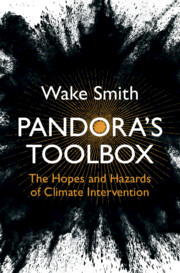Book contents
- Reviews
- Pandora’s Toolbox
- Pandora’s Toolbox
- Copyright page
- Dedication
- Contents
- Figures
- Tables
- Prologue
- Acknowledgments
- Section I Climate Introduction
- Section II Responses to Climate Change
- Section III Carbon Dioxide Removal
- Section IV Solar Radiation Management
- Section V Social Ramifications of Climate Intervention
- 16 Governance of Carbon Removal
- 17 Governance of SRM and SAI
- 18 Ethics
- 19 Public Perception
- Section VI The Path Forward
- Acronyms
- Appendix: Detail in respect of Figures 9.4–9.8
- Notes
- Index
16 - Governance of Carbon Removal
from Section V - Social Ramifications of Climate Intervention
Published online by Cambridge University Press: 24 February 2022
- Reviews
- Pandora’s Toolbox
- Pandora’s Toolbox
- Copyright page
- Dedication
- Contents
- Figures
- Tables
- Prologue
- Acknowledgments
- Section I Climate Introduction
- Section II Responses to Climate Change
- Section III Carbon Dioxide Removal
- Section IV Solar Radiation Management
- Section V Social Ramifications of Climate Intervention
- 16 Governance of Carbon Removal
- 17 Governance of SRM and SAI
- 18 Ethics
- 19 Public Perception
- Section VI The Path Forward
- Acronyms
- Appendix: Detail in respect of Figures 9.4–9.8
- Notes
- Index
Summary
This chapter pivots to social science and reviews the leading literature in respect of the governance of climate intervention. It starts with the influential Oxford Principles that derived from a 2009 report on geoengineering issued by the (British) Royal Society. It proceeds to consider the particular challenges presented by collective action problems like emissions reduction. It notes that the all-voluntary nature of nationally determined contributions under the Paris Agreement render this a rather light touch governance architecture, but that the carbon accounting rules being promulgated are essential to success. Carbon removal is a collective action problem very similar to emissions reduction, such that the Paris Agreement may also prove well suited to governing CDR. Nonetheless, several social scientists see risks in mixing emissions and carbon capture targets and would seek to maintain separate targets for each. As CDR may well continue long after emissions have been reduced to zero, the dynamics of post-zero CDR governance are also considered.
Keywords
- Type
- Chapter
- Information
- Pandora's ToolboxThe Hopes and Hazards of Climate Intervention, pp. 251 - 263Publisher: Cambridge University PressPrint publication year: 2022

